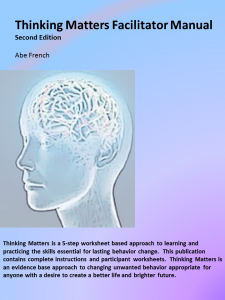We use a 5 step cognitive behavioral approach to lasting behavioral change.
Step one: Helps us separate the action taken in a situation from our viewpoint of the situation. The skill of seeing the difference between our viewpoint and the facts helps us to see our own responsibility. It also, helps us to understand that we need not take responsibility for the actions of others. Blaming others for our decisions and behavior allows others to have unnecessary power over our lives.
 Step 2: Helps us to find the thinking, feelings, attitudes and beliefs we used in a certain situation. The exercises in step 2 are designed to sort through the situation as if the situation is happening in the “here and now”. This gives us a chance to practice looking at our thoughts and feelings when things are not urgent. Calmly viewing the thoughts and feelings that happened before action was taken can show us how certain thinking can lead to problems and regretful decisions.
Step 2: Helps us to find the thinking, feelings, attitudes and beliefs we used in a certain situation. The exercises in step 2 are designed to sort through the situation as if the situation is happening in the “here and now”. This gives us a chance to practice looking at our thoughts and feelings when things are not urgent. Calmly viewing the thoughts and feelings that happened before action was taken can show us how certain thinking can lead to problems and regretful decisions.
Step 3: Helps us look at the meaning we see in situations. Meaning is significant because it helps us determine what is important to us. If something is very important, things seem more urgent. When this happens it is difficult to remain calm or consider different options. Many of us make bad decisions because we believe it is important to make a decision quickly instead of taking more time to consider different viewpoints. Step 3 provides practice looking at how the meaning we assign is important for making decisions
Step 4: Helps us to look at our thinking as a connected set of parts. We usually have patterns in our thinking that come from habits we have learned through our life experiences. Step 4 helps us see that the way we think is often important for making decisions that lead to trouble. Looking at the way our thinking is connected to feelings, and expectations can help us practice becoming more aware that small pieces of thought can be important.
 Step 5: Helps us look for thinking that leads away from trouble or hurting others. It is often very hard to think in new ways when it seems so important to act NOW. Step 5 helps us practice looking for new thinking when it doesn’t seem urgent. This helps us look at new thinking as a real possibility and helps us become more comfortable thinking in ways that are not familiar to us. When the time comes to use new thinking it will be more comfortable and less unfamiliar.
Step 5: Helps us look for thinking that leads away from trouble or hurting others. It is often very hard to think in new ways when it seems so important to act NOW. Step 5 helps us practice looking for new thinking when it doesn’t seem urgent. This helps us look at new thinking as a real possibility and helps us become more comfortable thinking in ways that are not familiar to us. When the time comes to use new thinking it will be more comfortable and less unfamiliar.



